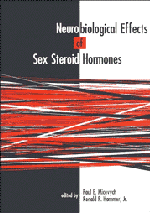Book contents
- Frontmatter
- Contents
- List of contributors
- Dedication
- Preface
- Acknowledgments
- Part I Sex steroid–responsive circuits regulating male and female reproductive behaviors
- Part II Sex steroid interactions with specific neurochemical circuits
- 5 Ovarian steroid interactions with hypothalamic oxytocin circuits involved in reproductive behavior
- 6 Sex steroid regulation of hypothalamic opioid function
- 7 Effects of sex steroids on the cholecystokinin circuit modulating reproductive behavior
- 8 Cholinergic regulation of female sexual behavior
- 9 Sex steroid regulation of tachykinin peptides in neuronal circuitry mediating reproductive functions
- 10 Dopaminergic influences on male rat sexual behavior
- 11 Studying neurotransmitter systems to understand the development and function of sex differences in the brain: the case of vasopressin
- Part III Cellular and molecular mechanisms regulated by sex steroids
- Index
9 - Sex steroid regulation of tachykinin peptides in neuronal circuitry mediating reproductive functions
Published online by Cambridge University Press: 15 October 2009
- Frontmatter
- Contents
- List of contributors
- Dedication
- Preface
- Acknowledgments
- Part I Sex steroid–responsive circuits regulating male and female reproductive behaviors
- Part II Sex steroid interactions with specific neurochemical circuits
- 5 Ovarian steroid interactions with hypothalamic oxytocin circuits involved in reproductive behavior
- 6 Sex steroid regulation of hypothalamic opioid function
- 7 Effects of sex steroids on the cholecystokinin circuit modulating reproductive behavior
- 8 Cholinergic regulation of female sexual behavior
- 9 Sex steroid regulation of tachykinin peptides in neuronal circuitry mediating reproductive functions
- 10 Dopaminergic influences on male rat sexual behavior
- 11 Studying neurotransmitter systems to understand the development and function of sex differences in the brain: the case of vasopressin
- Part III Cellular and molecular mechanisms regulated by sex steroids
- Index
Summary
Substance P is the best-known member of the family of tachykinin (TAC) peptides. Its distribution in spinal ganglia and substantia gelatinosa of the dorsal horn initially suggested a role in the transmission of sensory information from the periphery to the central nervous system (Hokfelt et al. 1975). Subsequently, an extensive distribution in the limbic system and brain stem (Ljungdahl et al. 1978) implicated these peptides in integrative and other processes as well. Mammalian TAC peptides are derived from two separate genes, usually designated preprotachykinins A and B. Preprotachykinin A mRNA codes for substance P, neurokinin A (NKA), neuropeptide K (NPK), and neuropeptide γ (NKγ; Krause et al. 1990), and preprotachykinin B mRNA codes for neurokinin B (NKB). Thus, the rat central nervous system contains at least five TAC peptides (Arai and Emson, 1986; Takano et al. 1986; Takeda et al. 1990; Tatemoto et al. 1985). Although substance P has a well-established role in the regulation of luteinizing hormone–releasing hormone (LHRH) secretion and sexual behavior, reproductively relevant roles for other TAC peptides are only now being explored. Much of what we can infer about the functional roles of TAC peptides in the central nervous system is derived from immunohistochemical studies, but antibodies to substance P often cross-react with other TAC peptides. Therefore, we have used the term “TAC-immunoreactive” (TACir) to describe the labeling of cells using antibodies directed against these peptides.
- Type
- Chapter
- Information
- Neurobiological Effects of Sex Steroid Hormones , pp. 207 - 233Publisher: Cambridge University PressPrint publication year: 1995
- 9
- Cited by



